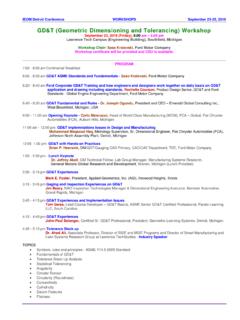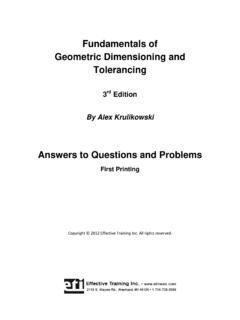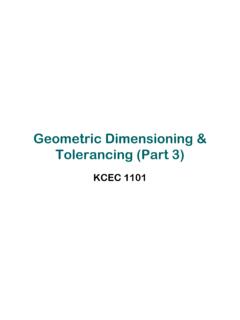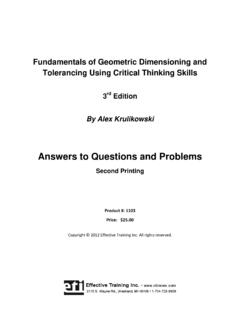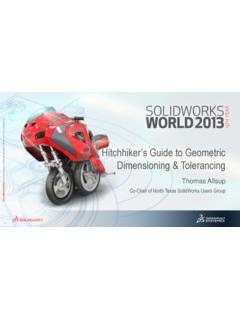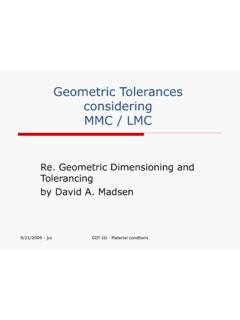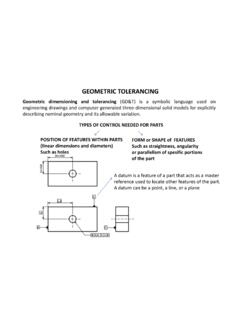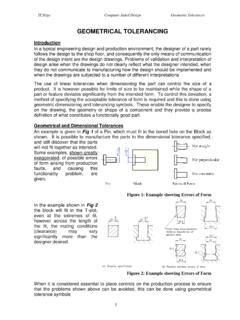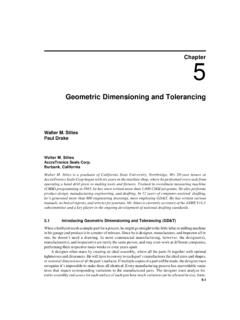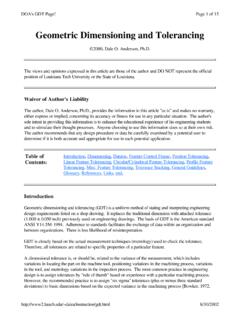Transcription of Geometric Dimensioning & Tolerancing (GD&T)
1 Geometric Dimensioning & Tolerancing (GD&T) to ASME 2009 Course No. 535 FOR WHOM INTENDED: This course is based on the latest ASME Y 2009 standard. It is intended for individuals per-forming inspection, design, manufacturing and assembly. Under-standing Geometric Dimensioning and Tolerancing is essential for anyone reading blue prints BRIEF COURSE DESCRIPTION: Course 535 covers the first six units of the GeoTol Pro Workbook, Al Neumann s full color practi-cal guide to Geometric Tolerancing that will provide a solid geo-metric foundation upon which to build, including any related 2009 changes.
2 The course commences by introducing GD&T, the concepts of size control and material tolerances. After defining the terminology to be used, Geometric characteristics and symbols, the course proceeds to demonstrate how the Geometric system works. Limits of size, position verification, product plans and virtual condition, along with the datum reference frame are discussed in detail during the presentation. The course covers Geometric symbols, application of modifiers like MMC, RFS and LMC along with application of position toler-ance measurement and limits of size including virtual condition.
3 The course concludes with a unit on the datum reference frame to ensure students understand how to apply datums to functional parts. Datum features and the degrees of freedom that are con-strained by the datum will be explained, permitting a thorough understanding and better application of datums. Exercises are completed throughout the course to reinforce fun-damental principles from which the student will build. Practical drawing applications and engineering wood models are used to help student understanding and assist with the correct application and interpretation of geometrics.
4 Students will participate and be engaged in practical exercises to demonstrate their understanding of the material covered. Participants successfully completing this course will be able to un-derstand, evaluate and correctly apply Geometric Dimensioning and Tolerancing . They will be able to read and fully understand geometrics on any engineering drawing. DIPLOMA PROGRAMS: This course may be used as an elective for TTi's Metrology/Calibration Specialist (MSC) or Mechanical Design Specialist (MDS) Diploma Programs, or for any other TTi specialist diploma program.
5 RELATED COURSES: Day One of Course 535 is also offered separately as Course 534, Introduction to Geometric Dimensioning and Tolerancing . Course 536, Intermediate/Advanced GD&T picks up where Course 535 leaves off. Course 537, Tolerance Stacks and App-lications, is also available. PREREQUISITES: There are no definite prerequisites for this course. However, this course is intended for individuals involved in a related technical field. TEXT Each student will receive a full-color course workbook, Al Neumann s Geo Tol Pro Workbook, A Practical Guide to Geometric Tolerancing per ASME 2009, which is considered the definitive reference work in the GD&T industry.
6 COURSE HOURS, CERTIFICATE AND CEUs Class hours/days for on-site courses can vary from 14 35 hours over 2 5 days as reques-ted by our clients. Upon successful course completion, each partici-pant receives a certificate of completion and one Continuing Educa-tion Unit (CEU) for every ten class hours. Course Outline Introduction, Symbols and Terms Symbols, Terminology Limits of Size Go-No Go Gages Hub application Quality product plans: Manufacturing, Dimensional Inspection How the Geometric System Works Plus / Minus Tolerancing comparison Hole Bar Example Material Condition Modifiers Effect of Zero Tolerancing at MMC Position Tolerance Verification Hole verification Measurement conversion Cartesian and Polar Coordinates Paper Gage Product Plans and Virtual Condition Hub application Quality Product Plans Product Plan Manufacturing Dimensional Inspection Virtual Condition Datum Reference Frame Theory Implied datums Simulators.
7 Features with and without size Datum Feature Simulator Requirements Establishing and Qualifying a DRF Degrees of Freedom Student Exercises-utilizing full color course material in a practical application Award of Certificates for Successful Completion Technology Training, Inc. (a tti group company) Toll-free telephone: 866-884-4338 (866-TTi-4edu) 805/845-5050 E-mail: 190205
